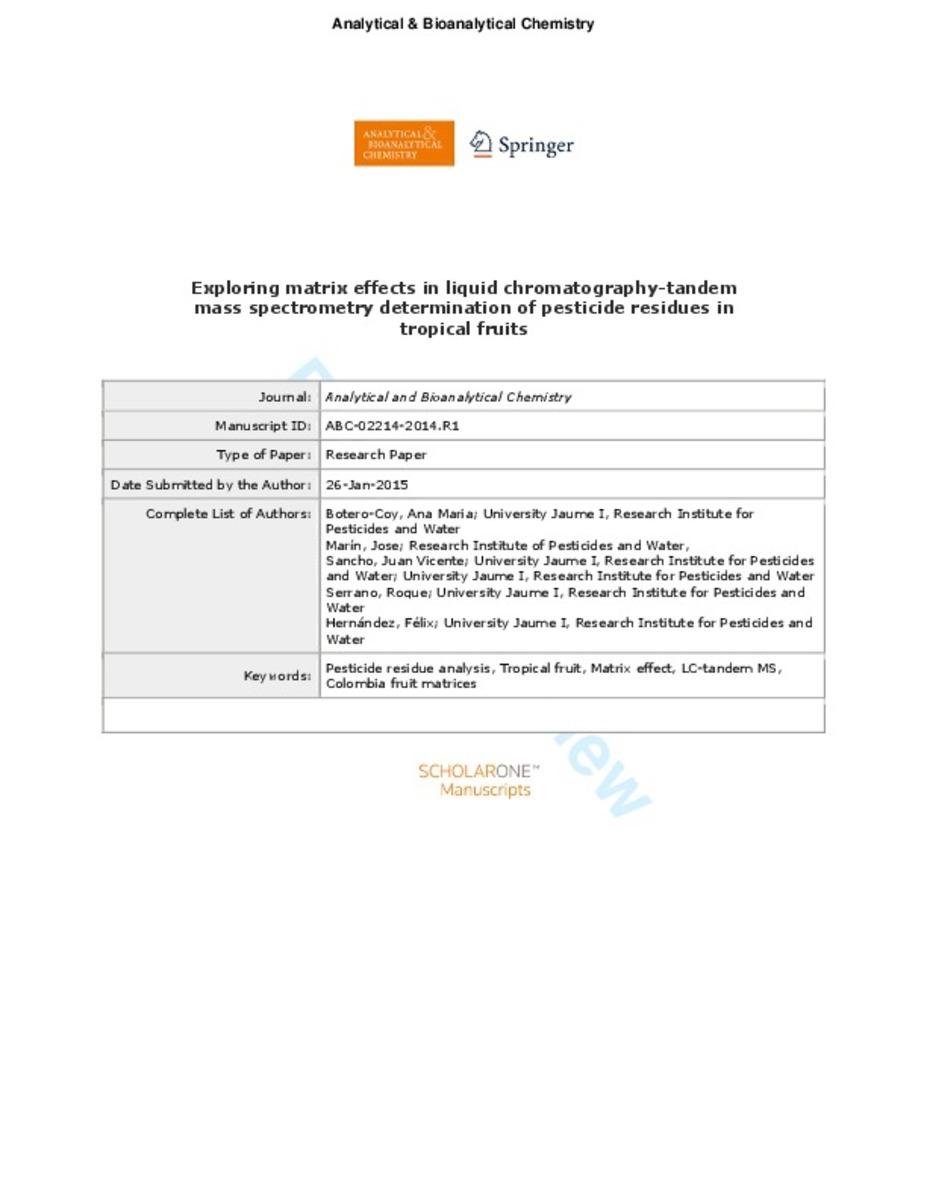Mostrar el registro sencillo del ítem
Exploring matrix effects in liquid chromatography–tandem mass spectrometry determination of pesticide residues in tropical fruits
| dc.contributor.author | Botero-Coy, Ana Maria | |
| dc.contributor.author | Marín Ramos, José Manuel | |
| dc.contributor.author | Serrano, Roque | |
| dc.contributor.author | Sancho, Juan V | |
| dc.date.accessioned | 2015-12-17T16:10:26Z | |
| dc.date.available | 2015-12-17T16:10:26Z | |
| dc.date.issued | 2015-12-17 | |
| dc.identifier.issn | 1618-2642 | |
| dc.identifier.issn | 1618-2650 | |
| dc.identifier.uri | http://hdl.handle.net/10234/143945 | |
| dc.description.abstract | Tropical fruits are being increasingly consumed around the world because of their appreciated characteristics, particularly their high nutritional value and distinctive taste, which are different from those of traditional fruits. Owing to their introduction into international markets it is necessary to have a reliable analytical methodology available for the sensitive determination of pesticide residues in order to monitor the compliance of maximum residue limits (MRLs). From an analytical point of view, tropical fruits have generally been far less studied than other fruits frequently consumed in the European Union or USA, which are among the most important markets. In this work, LC–MS/MS-based methodology using a triple quadrupole analyzer was developed for the multi-residue determination of selected pesticides and metabolites in tropical fruits, which were selected among the most popular in Colombia, one of the most important suppliers of tropical fruits around the world. After selection of a QuEChERS (Quick, Easy, Cheap, Effective, Rugged, and Safe)-based sample treatment, the study focused on the evaluation of matrix effects, in order to find a simple way for their correction. Twelve different food matrices were selected to perform this study: the seven Colombian tropical fruits of highest value for domestic and international markets (uchuva, tamarillo, granadilla, gulupa, maracuya, papaya, and pithaya), and five more matrices highly consumed in Colombia (lulo, carambolo, feijoa, mangostan, and guayaba). Twenty compounds, including pesticides widely applied in tropical fruits pest control and several metabolites considered in residue definition, were used as model compounds in this work. Correction factors were used on the basis of calibration graphs obtained with standards in solvent and in matrix, and their usefulness was supported by validation of the method in all the matrices tested at 0.01 and 0.1 mg/kg. The analysis of real-world samples revealed the presence of several target compounds that were identified by the acquisition of two MS/MS transitions, and by ion intensity ratio and retention time agreement. | ca_CA |
| dc.description.sponsorShip | Generalitat Valenciana (Research Group of Excellence Prometeo 2009/ 054 and Prometeo II 2014/023; Collaborative Research on Environment and Food-Safety, ISIC/2012/016) | |
| dc.format.extent | 15 p. | ca_CA |
| dc.format.mimetype | application/pdf | ca_CA |
| dc.language.iso | cat | ca_CA |
| dc.relation.isPartOf | Analytical and bioanalytical chemistry, 2015, vol. 407, núm. 13 | |
| dc.rights | © Springer International Publishing AG, Part of Springer Science+Business Media. "The final publication is available at Springer via http://dx.doi.org/10.1007/s00216-015-8586-5" | ca_CA |
| dc.rights.uri | http://rightsstatements.org/vocab/InC/1.0/ | * |
| dc.subject | Pesticide residue analysis | ca_CA |
| dc.subject | Tropical fruits | ca_CA |
| dc.subject | Matrix effects | ca_CA |
| dc.subject | LC–tandem MS | ca_CA |
| dc.subject | Colombia fruit matrices | ca_CA |
| dc.title | Exploring matrix effects in liquid chromatography–tandem mass spectrometry determination of pesticide residues in tropical fruits | |
| dc.type | info:eu-repo/semantics/article | |
| dc.identifier.doi | http://dx.doi.org/10.1007/s00216-015-8586-5 | |
| dc.rights.accessRights | info:eu-repo/semantics/openAccess | ca_CA |
| dc.relation.publisherVersion | http://link.springer.com/article/10.1007%2Fs00216-015-8586-5 | ca_CA |
| dc.type.version | info:eu-repo/semantics/acceptedVersion |
Ficheros en el ítem
Este ítem aparece en la(s) siguiente(s) colección(ones)
-
QFA_Articles [817]
Articles de publicacions periòdiques -
IUPA_Articles [307]







